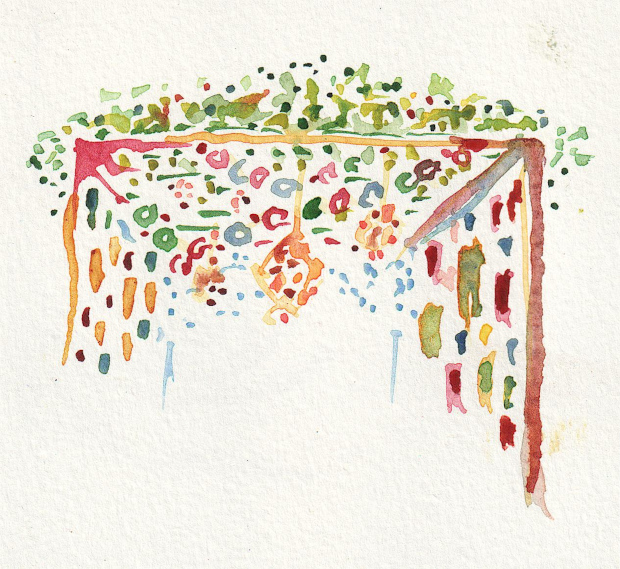
Every year I come up with new ideas on how to decorate a sukkah. This year for the first time I led a group of children, teens, and adults in creating sukkah decorations.
What is a Sukkah?
A sukkah is a temporary structure that Jews eat (and a few sleep) in during the fall holiday of Sukkot. It is topped with natural materials such as branches or bamboo. I enjoy decorating our sukkah. This gives the whole experience an extra hiddur mitzvah (beautification of a good deed).
What Kinds of Decorations?
Living in the Northeast of the U.S., the weather is unpredictable in the early fall. It often rains. So we have to waterproof our decorations as much as possible. To find ideas for decorations, I started looking up: “waterproof loop chains”. Having no success with that search, I soon learned that I should just look up “sukkah decorations”.
A sukkah has four walls. It also has schach, branches or slats of natural material that cover the top. In my mind, the decorations are divided into wall pictures and top hangings. If you have a solid wall on at least one side, that works for wall pictures.
When I was growing up, we had a canvas sukkah. It was hard to decorate the sides of canvas. So we hung decorations from the top. I have memories of sitting in the kitchen with my mother z”l, stringing cranberries.
In this post I will present different kinds of decorations.
Laminated Pictures
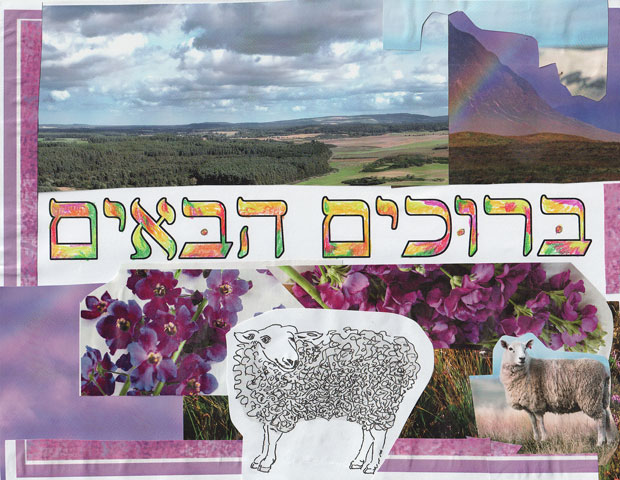
This is a laminated collage that I created with some cutouts and a printed Hebrew bruchim habaim (Welcome). I typed the letters in Hebrew using Gimp, a free software program. The cutouts are all from magazines or old flyers except for the ink sheep. I drew that one a few months ago. I colored in the letters with Derwent colored pencils.
When my children were little, they would bring home all kinds of laminated pictures. Many of these are still hung in our sukkah each year. The walls of our sukkah are covered with laminated pictures.
Pictures can have text, photos, glued cut outs from magazines or drawings. You can use crayons, markers, colored pencil or paint. I like adding new family photos to our sukkah each year. You can use hook and loop adhesives to attach your laminated picture. Hook and loop tape comes in rolls. One side is fuzzy. They easily attach and detach from each other. It makes it easy to re-use the pictures each year. I have bought hook and loop tape in the past on Amazon. This year I bought a few rolls of different sizes from the sewing company called Wawak.
One good idea for a sukkah picture is make a collage. First, take a photo. Then cut all kinds of magazine pieces, construction paper, and pretty papers. Place the photo in the center of a standard 8.5 x 11 printer paper. Create a design around the photo with cut outs. It can be color-themed, look like a sukkah, or just be whatever appeals to you. Once you are happy with the design, glue everything into place. Then run it through the laminator.
Last year I bought a laminator. You can find them on Amazon for not too much money. I used to struggle with clear contact paper to cover photos. A laminator is much easier. You also need to buy special plastic sleeves to enclose your photo or picture. This is a fun craft project for children or for seniors.
Loops and Chains
A traditional sukkah decoration is a long chain of loops. One could make paper loops in a sukkah. However, these are not waterproof. This year we made loops out of colorful plastic cable ties. You can buy colorful plastic ties on Amazon. You can see the loops in the pictures below of the etrog sun catcher and the plastic bottles apple.
Etrog Sun Catchers
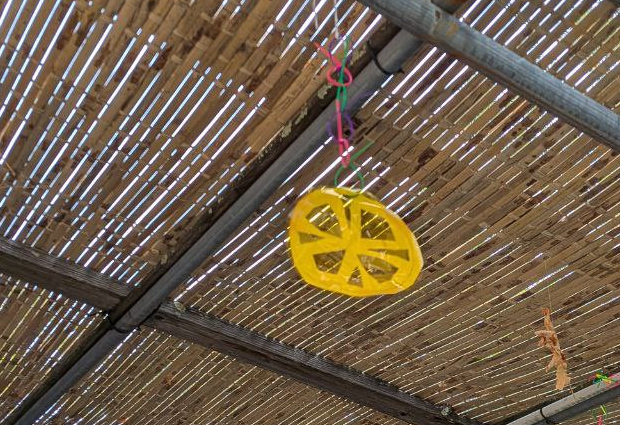
I found a blog post on creating these bright citron sun catchers. You need yellow cellophane (available on Amazon), yellow or orange construction paper, scissors, clear plastic tape, and string. The tricky part is the cutting of the paper. Other than that, I found children of varying ages were able to make these.
Someone in our group used red cellophane to create a big pomegranate. I am thinking next year I will buy purple cellophane so we can make grape sun catchers.
Apples Out of Bottle Bottoms
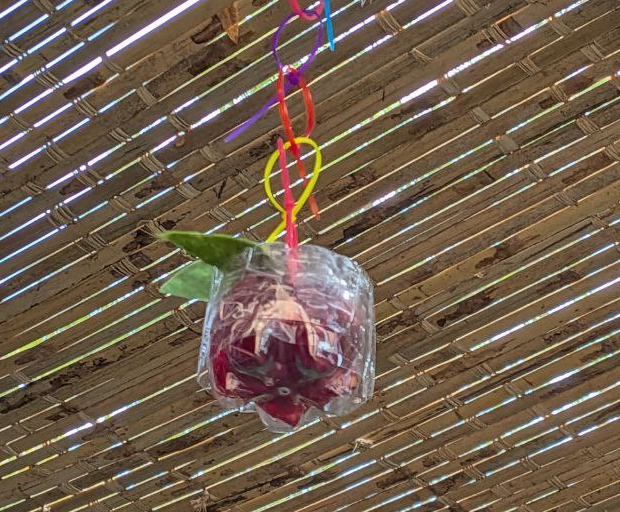
These apples from plastic bottles are a bit challenging to make. Children would need supervision and help to make them. First, you have to collect plastic water bottles with bumpy bottoms and with smoother bottoms. You create the apple by putting one plastic bottle top on the top and the bumpy one on the bottom. You add bits of red cellophane and/or red fabric to the inside. Green leaves go on top. I did the leaves with felt and sewed two leaves together. Then I glued them to the top of the apple. If you want to introduce hand sewing to someone, this is a good project to try. The hardest part is making two holes on the top of the apple in the plastic.
I am hoping to find even more projects to decorate the sukkah for next year.
Happy 5786! Hope you and your family have a happy, sweet new year.
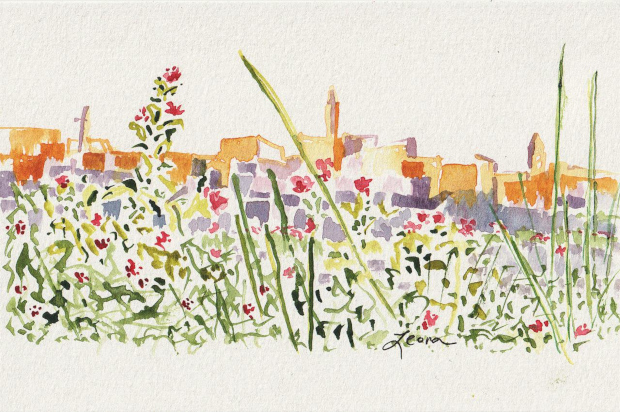
My last visit to Jerusalem was almost ten years ago. I photographed some red flowers billowing in front of the Old City of Jerusalem.
A few days I was looking for inspiration. I found a printout of the photo I had taken. I thought about shapes, colors, and composition. I wanted to capture the beautiful Jerusalem light and bring a little joyous color to my viewers.
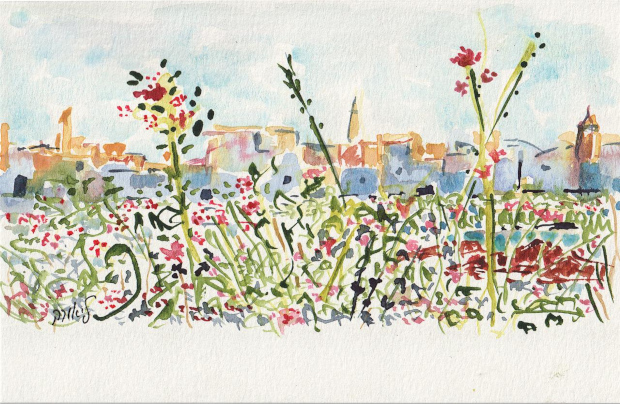
I hope you enjoy these watercolors.
And to end off, here is a shofar. We approach the New Year of 5786. The shofar tells it is time to do teshuva (repentance). May we all be blessed with a year of happiness, health, prosperity, and good deeds.
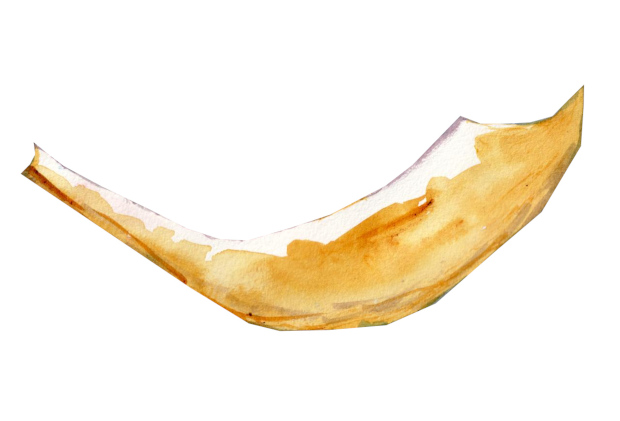
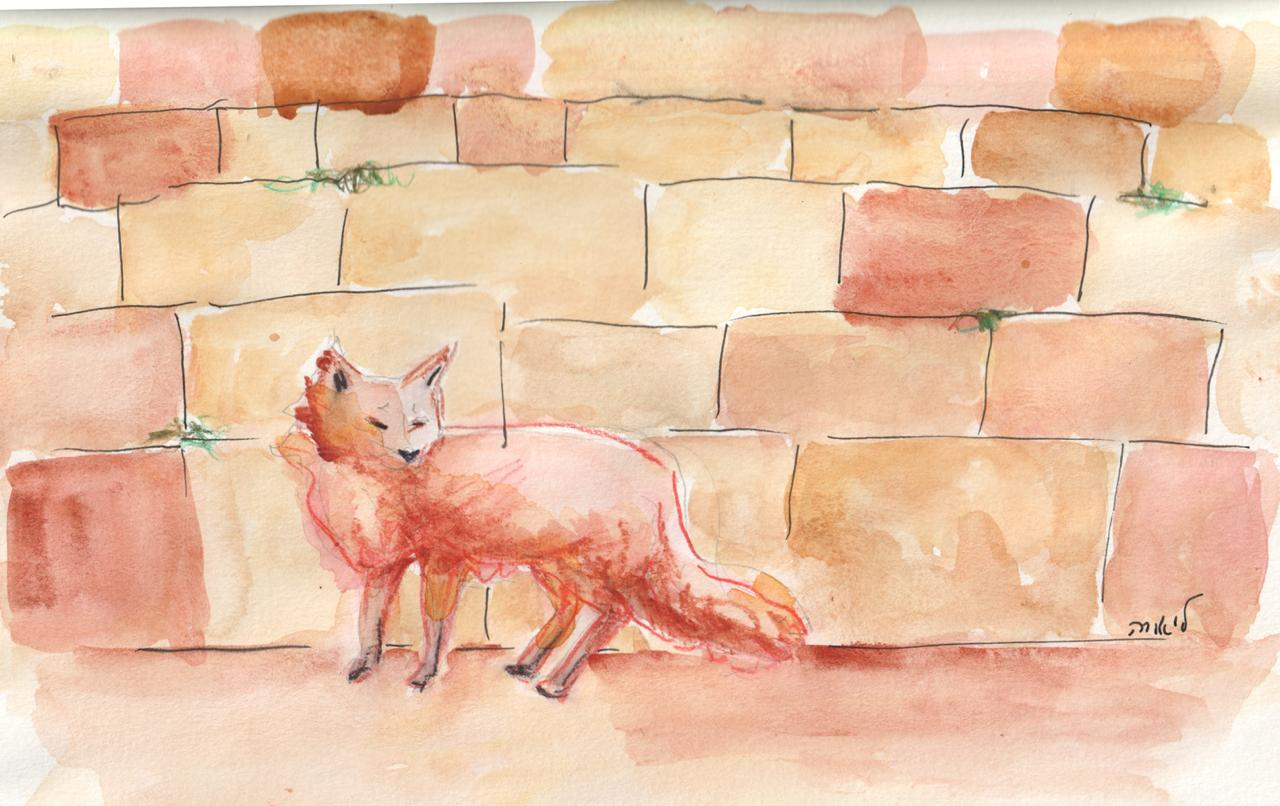
Tisha B’Av is the saddest day of the Jewish calendar. The Beit Hamikdash (holy Temple) was destroyed. In addition to fasting, one is supposed to limit activities to those that are mournful. I wrote more about Tisha B’Av in past years in particular about the story of the fox in ruins and another fox in ruins watercolor.
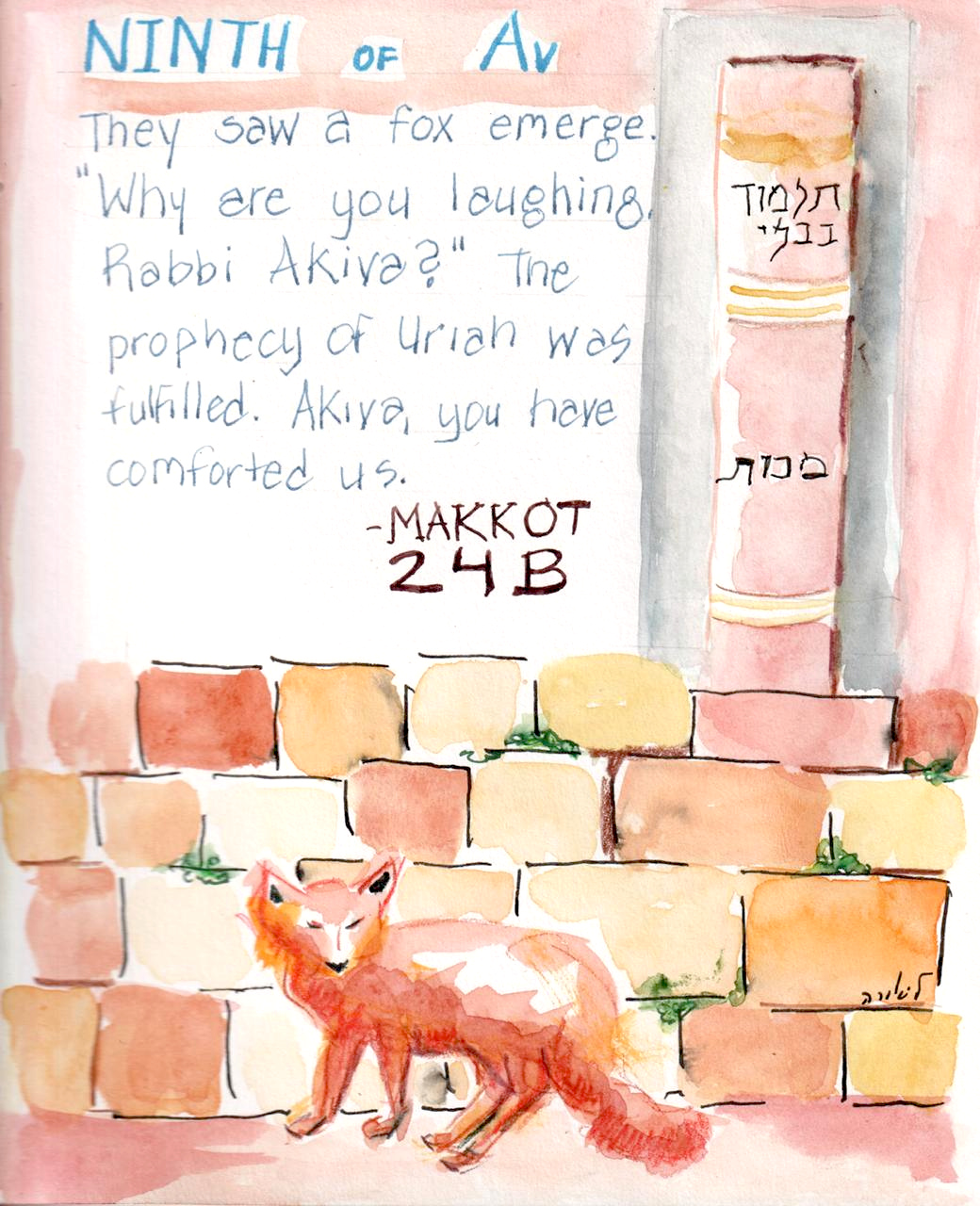
In this version I added an abridged version of the text from Makkot 24B. I added a volume of Makkot, one of the volumes of the Talmud, to the right.
They saw a fox emerge. “Why are you laughing, Rabbi Akiva?” The prophecy of Uriah was fulfilled. Akiva, you have comforted us. – Makkot 24B
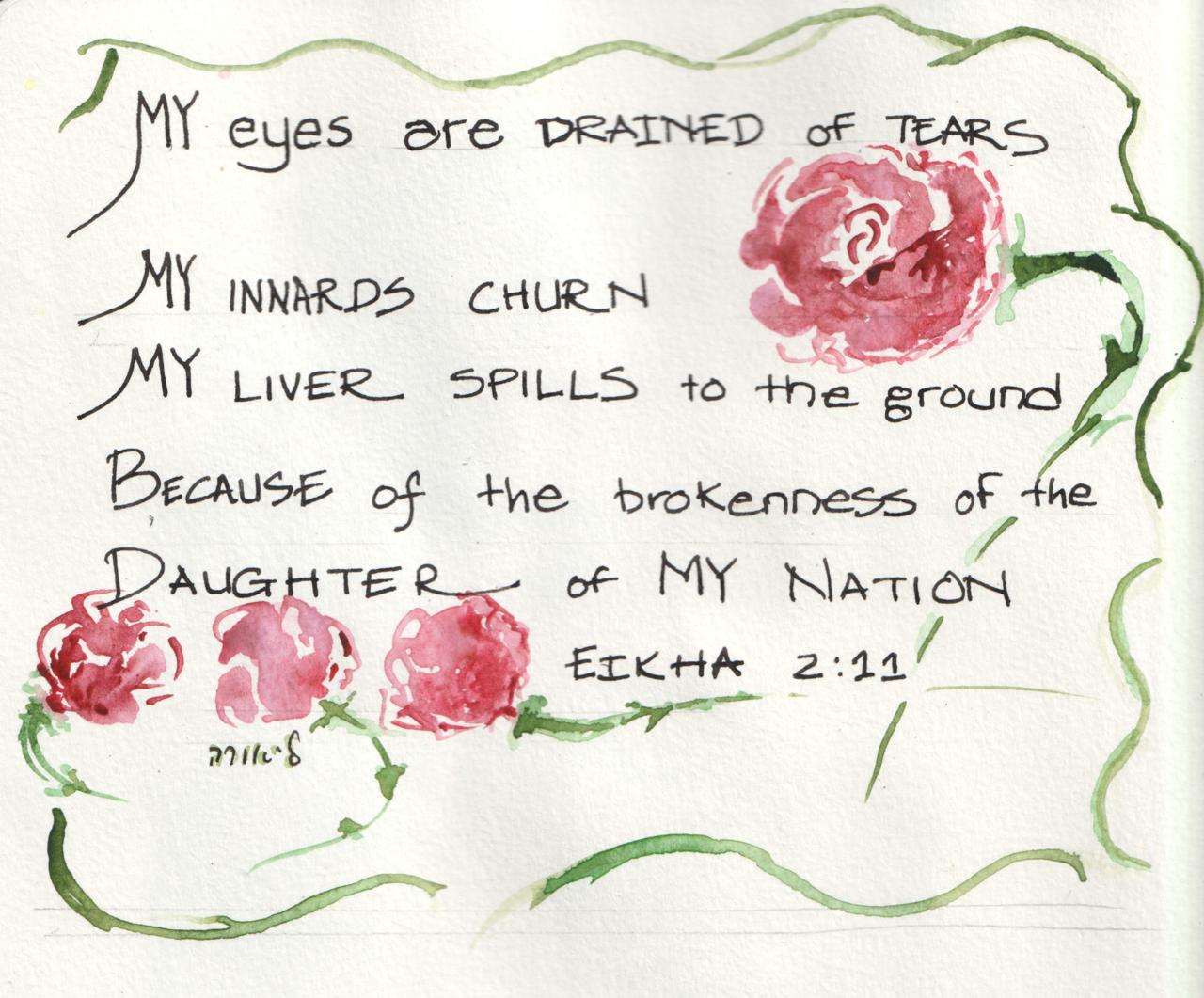
This year I also worked on my calligraphy by copying sections of Eikha (Lamentations), the megillah (scroll) that we read on the night of Tisha B’Av.
My eyes are drained of tears
My innards churn
My liver spills to the ground
Because of the brokenness of the daughter of my nation
— Eikha 2:11
This sketch was created with ink and watercolor on Tisha B’Av 5785.
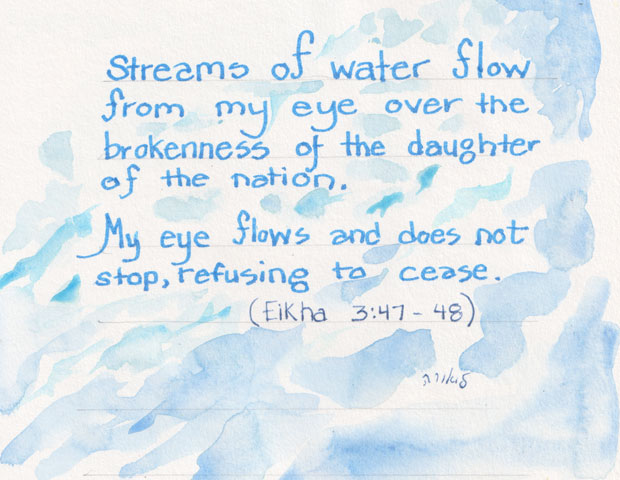
Streams of water flow from my eye over the brokenness of the daughter of the nation.
My eye flows and does not stop, refusing to cease.
(Eikha 3:47-48)
I love the feeling of painting water with watercolor.
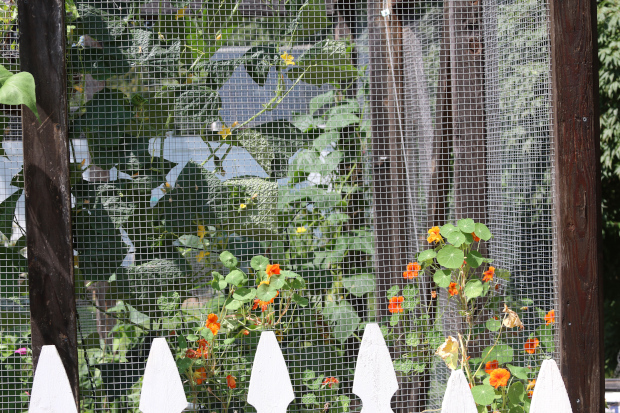
Because of the deer and other critters in our neighborhood, I grow my cucumbers in a cage. Pictured are the cucumber vines and climbing nasturtium. Nasturtium have yellow and orange edible flowers (and edible round leaves) that you can use to dress up your salads.
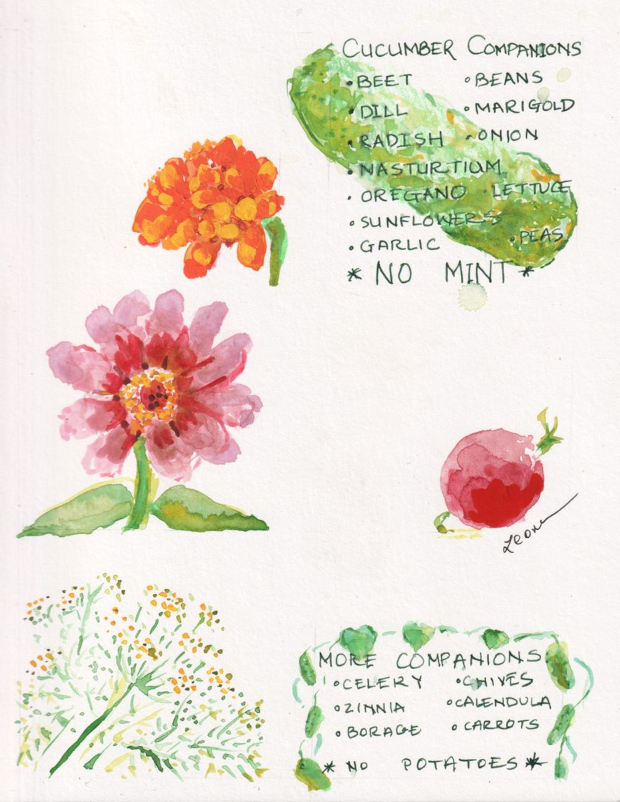
Growing cucumbers is not as simple as stick a few seeds in the ground and watch them grow. One needs provide good soil with proper nutrients, enough water, and a way for the plant to climb up. In addition it is a good idea to plant cucumber companions in the general vicinity of your cucumber plants. In order to learn what to plant and what not to plant, I did this art illustration. I already had nasturtium and radish in my cage. This year I sprinkled several zinnia seeds and moved the marigolds into the cage. I also removed some mint that was growing directly outside the cage. Dill is one of my favorite herbs, so I made a special effort to keep the dill going strong by adding compost around the base of each dill plant every few weeks.
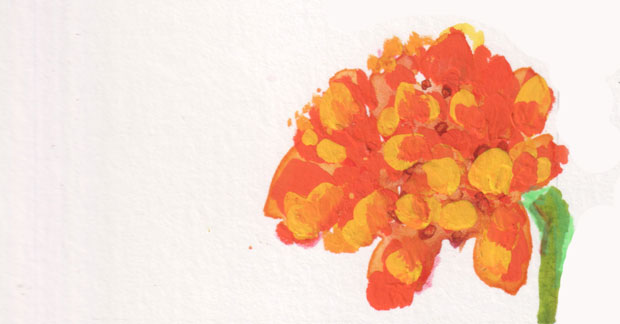
Marigolds are easy to grow. They are a good beginner plant. For some unknown reason, few of the marigold seeds that I saved from last year germinated. I was able to buy several marigold seedlings for a low price early in the spring at our local farmers market. Those are flourishing.
Painting flowers is harder than it looks. I first painted the marigold with watercolor. I didn’t think the orange was strong enough. I switched to gouache and applied thick, small strokes. I am happy with the result.
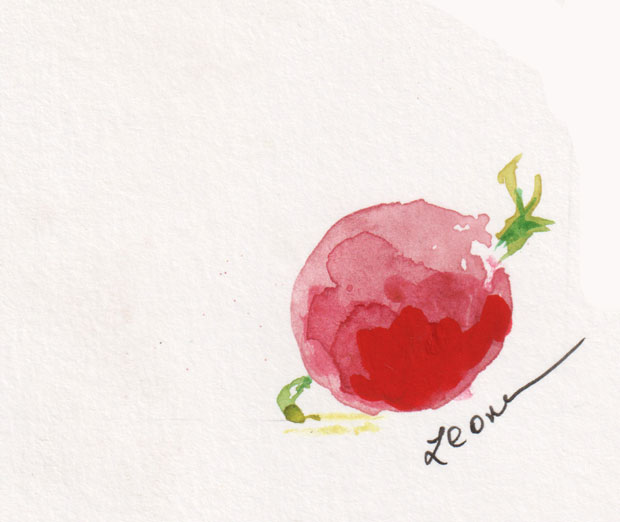
Radishes are easy to grow. You stick the seeds in the ground, and a week later you have round little leaves poking out of the ground. Make sure to plant in loose, rich soil, and in a month you will be pulling radishes. Sometimes I eat radishes raw. Sometimes I ferment them in a little jar with sea salt and filtered water. You can also steam the radishes if you like them sweet.
Radishes are easy to paint. Make sure you have a nice, thick red paint and a good brush. Paint a few layers, leaving one side a bit on the white side to show form.
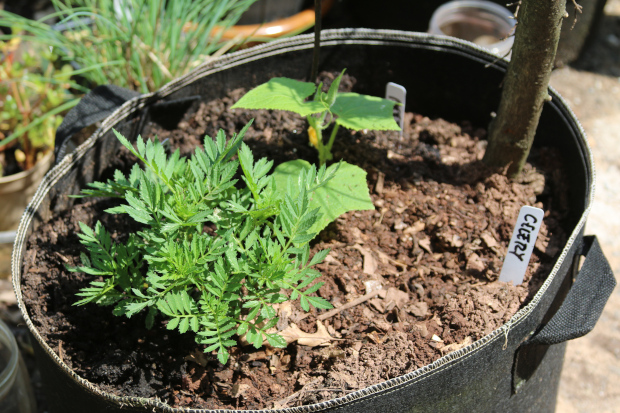
A friend gave me these large black cloth bags for planting. I am experimenting with a little container garden. Pictured are marigold and cucumber seedlings. I put in some celery seeds. Hopefully, sometime this fall we will get some celery.
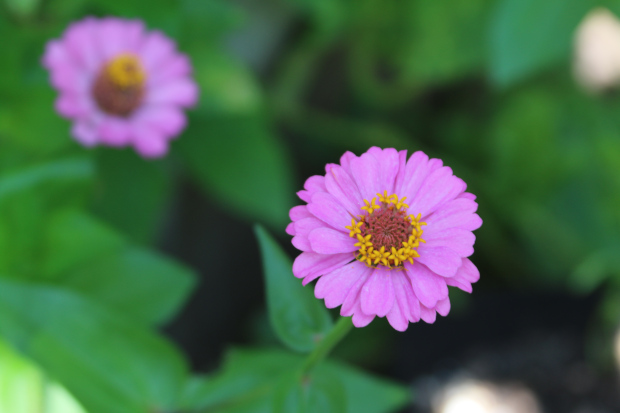
Zinnia come in a variety of colors. If you have full sun, a plot of land with decent, loose soil, and determination, you can sprinkle zinnia seeds in May or early June and receive the reward of flowers in the summer.
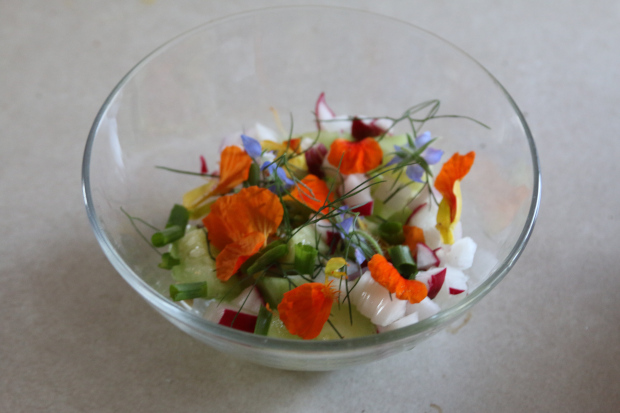
Have you ever eaten a nasturtium flower? What would you do with a radish? Have you eaten a cucumber that is not from a supermarket?
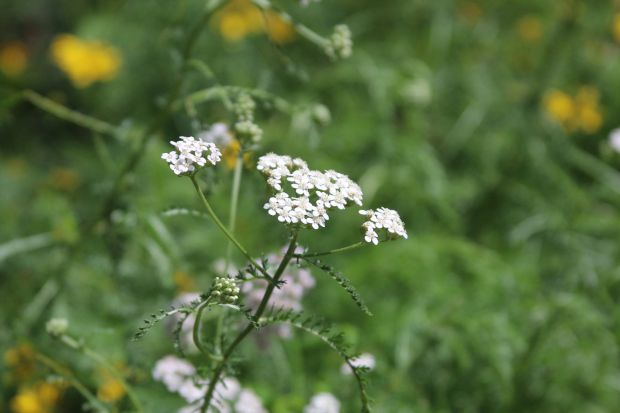
Someone asked me: why are you posting yarrow? Is it your favorite flower? No, I responded. My favorite flower, at least for this year, is cosmos.
So why am I posting about yarrow? I realized I am posting in order to learn yarrow’s health benefits. Here are a few:
- Improve digestion
- Accelerate wound healing
- Alleviate colds or the flu with yarrow tea
- Reduce inflammation
You can learn more about the healing properties of white yarrow (yarrow millefolium) elsewhere.
Yarrow comes in a variety of colors. In my backyard I have big yellow yarrow flowers that are currently in bloom in July. In the front of my house I have white yarrow. Yarrows are perennials. The Latin name is Achillea.
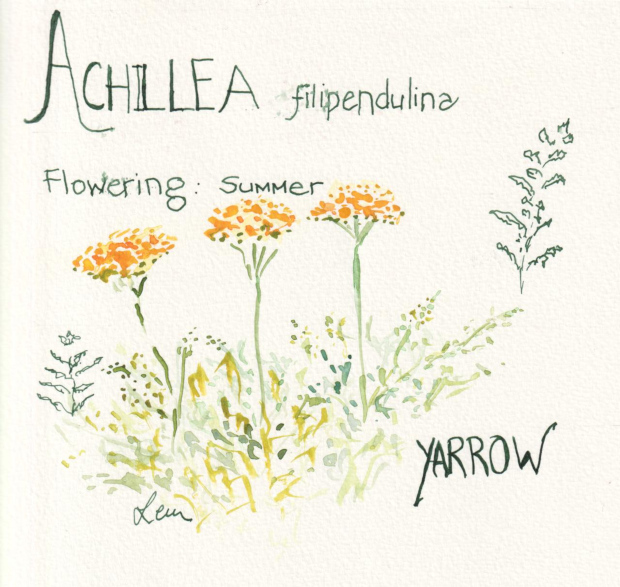
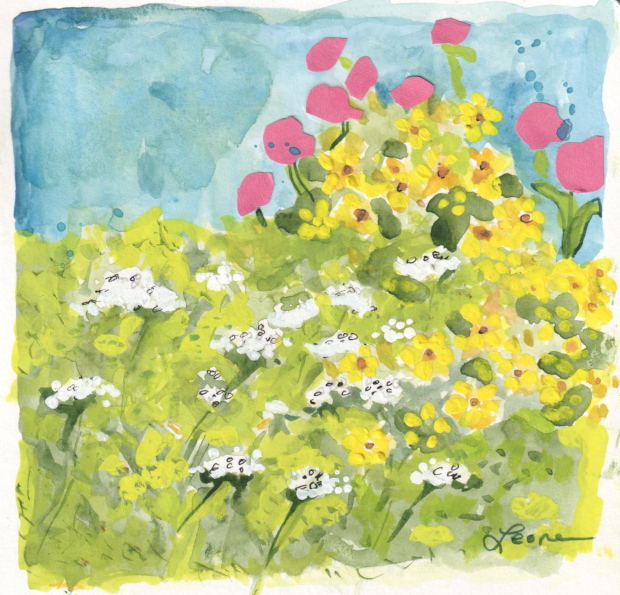
Pictured is achillea millefolium (white yarrow), coreopsis, and lamb’s ear flowers. I painted the illustration with watercolor, gouache, and collage for the bright pink lamb’s ear flowers.
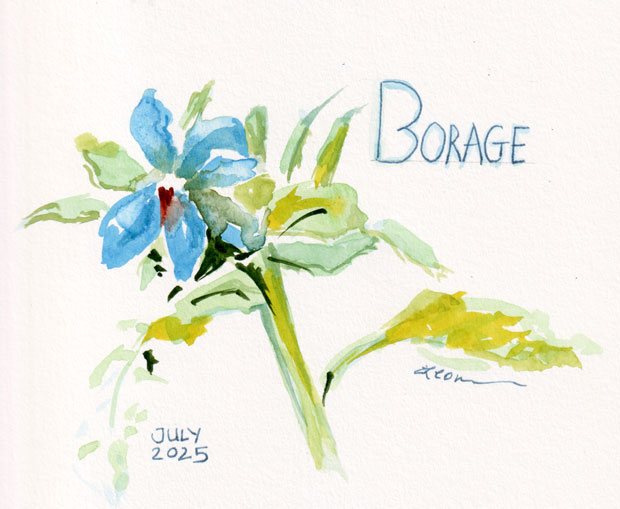
This was going to be a post about rudbeckia or black-eyed susan. However, a deer ate my beautiful yellow flower that miraculously blossomed in front of my house. So I looked for inspiration elsewhere.
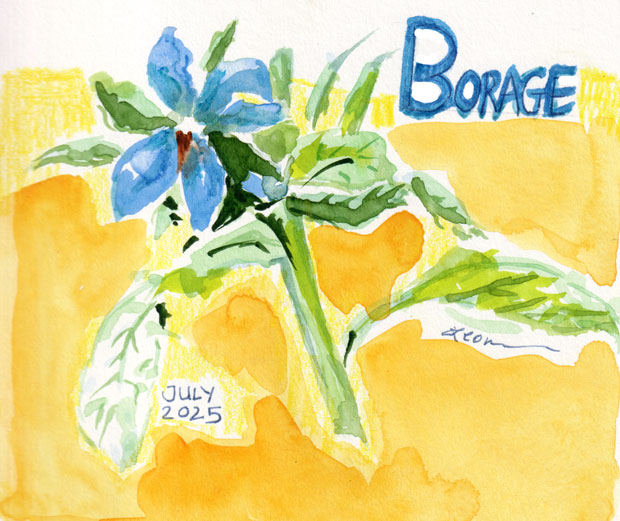
Borage is growing in my plant cage. I had the cage built because the deer ate most of my edible plants. This year I am concentrating on growing cucumbers. A good companion to cucumber plants is borage. I originally put three borage seedlings that I bought at the Highland Park Farmers Market in my backyard. However, despite my deer fence in the backyard, something nibbled at the borage. So off it went into the cage.
Borage is grown as an annual in New Jersey. It is native to the Mediterranean. Some special notes about borage: you can eat the flowers and the leaves. I have seen the flowers described as cornflower blue or as smoky blue. To me the blue is slightly on the purple side.
I sketched several pages about borage in my sketchbook.
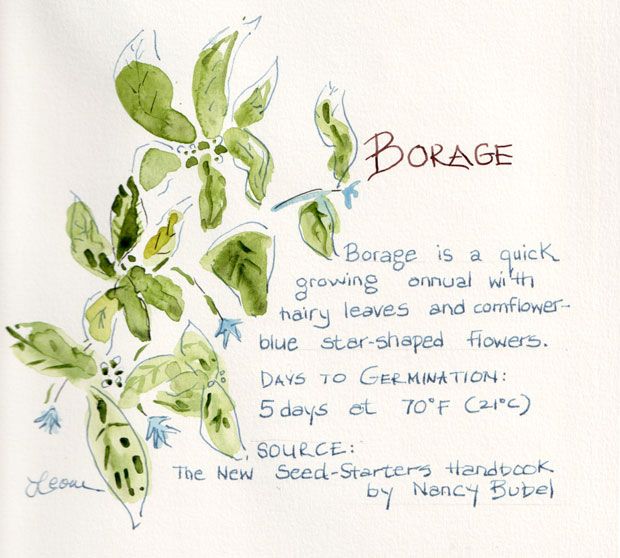
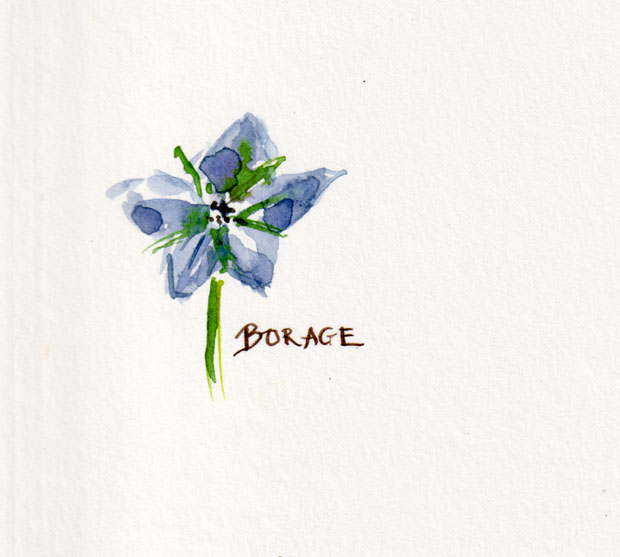
Borage is a quick growing annual with hairy leaves and cornflower-blue star-shaped flowers.
Days to Germination: 5 days at 70° F
Source: The New Seed-Starters Handbook by Nancy Bubel
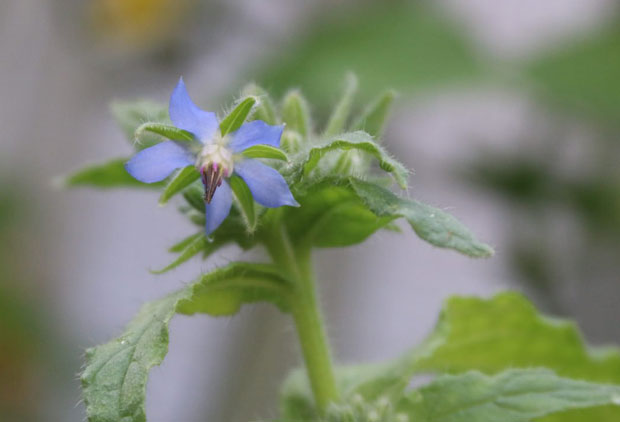
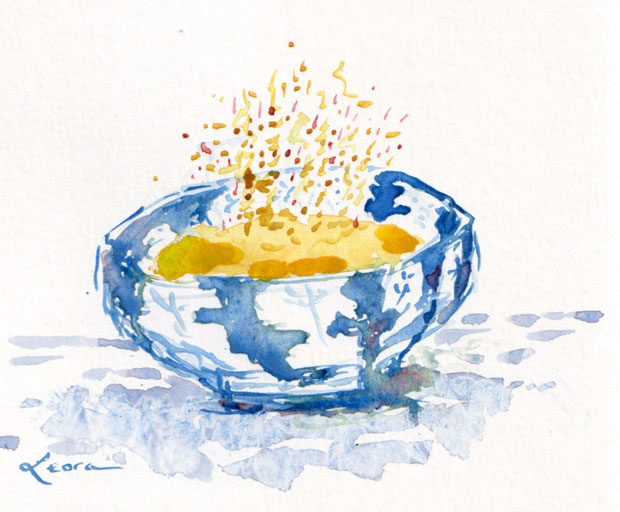
Magical Elixir Healing Chicken Beef Soup
Are you looking for more energy? Want to serve a delicious and nutritious soup to your family? This magical elixir healing soup is easy to make, and you can freeze any leftovers.
This soup is my version of the meat stock for Stage One of the GAPS diet, a healing diet. Also on Stage 1 are ferments (the juice of the brine, not the vegetables) such as sauerkraut (just sea salt and cabbage).
Ingredients
2-3 lbs. chicken bones
3 beef marrow bones
Filtered water, enough to cover the chicken and beef bones
3 Tbsp. Redmond Real Salt or Celtic Salt
2 small onions
2 carrots, peeled and cut into coin shapes (optional)
2 stalks celery with leaves
1-2 garlic cloves (optional)
2 peppercorns (optional)
3 white turnips, peeled and cut (optional)
Recipe for the soup
Put chicken bones and beef bones in a large pot. Fill water to cover the bones. Add the salt. Cook on medium, then simmer when it comes to a boil. Add the vegetables about 1 hour before serving. Cook for 2-3 hours total.
For more on the GAPS diet, see the blue book called GAPS Diet by Dr. Natasha Campbell-McBride. You can also learn by watching videos in which she is interviewed.
Note: whenever you can, use local produce. Get to know your local farmers.
A lot of people say they cannot draw. My response is: when you were in first grade, did you know algebra? Probably not.
The most important skill in drawing is learning to see. We think we can see, but often we think in symbols instead of actually seeing what is front of us and drawing only what we can see.
Get Started with Drawing
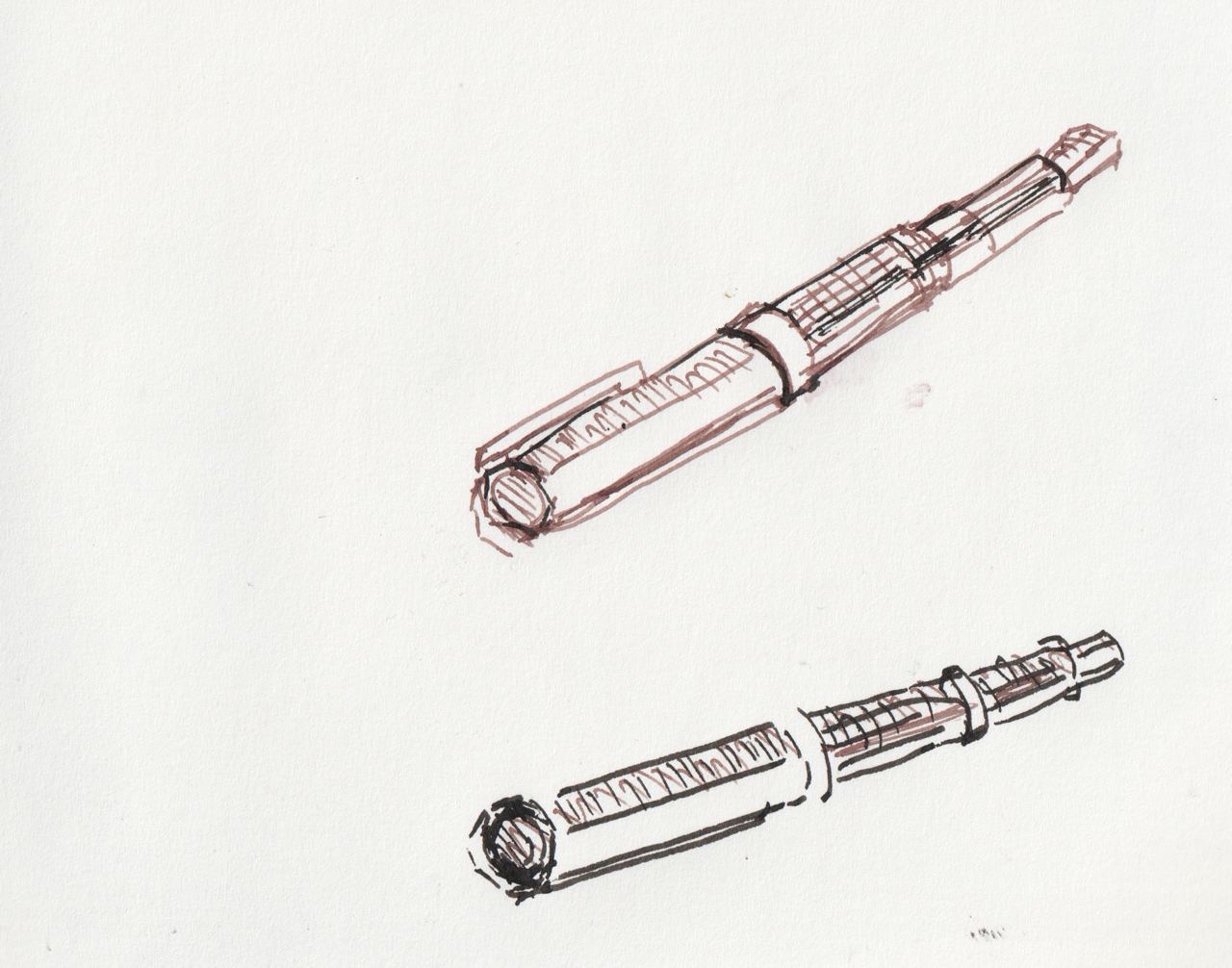
If you want to learn to draw, grab a pen and an old notebook. It doesn’t matter what pen, as long as it is not erasable. Any old notebook will do, even one that is almost filled. The less you care about anything that is already in the notebook, the better. Walk around your neighborhood. Draw whatever you see. Make sure not to show it to anyone. If you care about these first drawings, you probably won’t even get started.
Draw Blind: Learn to See Contours
Now that you have drawn something, it is time to do a little seeing. Set up a simple still life. It could be cups and boxes. It could be onions and apples. It doesn’t matter. Don’t look at your paper, and draw. Don’t cheat, especially the first time. For the next drawing, you can cheat a little and look. Try drawing in a continuous line. Do a third one. How do they look? Drawing without looking at the paper is called blind contours drawing. Drawing the contours of the objects in a scene without lifting your pen much from the paper is called a continuous line drawing.
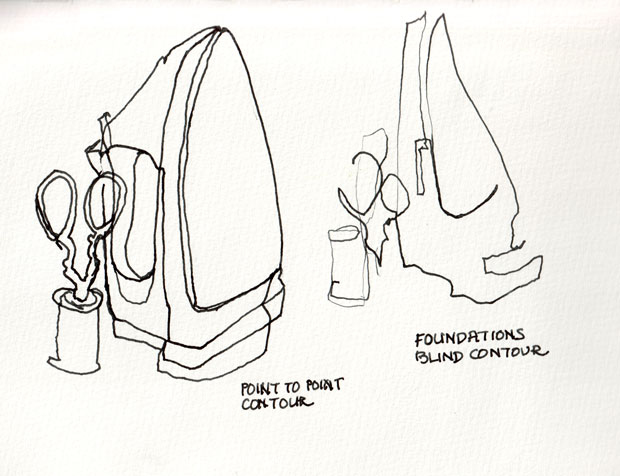
On the left is an example of a continuous line drawing of an iron. On the right is a blind contours drawing of the same iron.
To learn more about contour drawings, you might read the classic The Natural Way to Draw. Here is an excerpt:
Sit close to the object which you intend to draw. Focus your eyes on some point along the contour of the model. (The contour approximates what is usually spoken of as the outline or edge.) Place the point of your pencil on the paper. Imagine that the point is touching the object instead of the paper. Without taking your eyes off the object, wait until your are convinced the pencil is touching that point on the object upon which your eyes are fastened.
Then move your eyes slowly along the contour of the model and move the pencil slowly along the paper… this means that you must draw without looking at the paper.
Source: The Natural Way to Draw by Kimon Nicolaides, p. 9
Practice, Practice, Practice
Keep up with the drawing. Tuck a small sketchbook into your purse or back pack. Leave one in your kitchen or the drawer of your office. Pick a favorite ink pen. I like Uniball pens, but a cheap ballpoint pen can work as well. Draw your keys. Draw a book on the table. Draw the car parked down the street. If the weather is nice, go to the park and draw a tree. Start your drawing anywhere on the page. Spend more time looking at your subject than your paper. Do not erase.
Learn from the Masters
A great way to learn to draw is to copy a painting or illustration of one of the masters. For example, get a book with drawing by Rembrandt. Pick one, and copy it. Then try a totally different artist, maybe Van Gogh. Copy his drawing or painting. This is a great way to learn.
Favorite Drawing Books
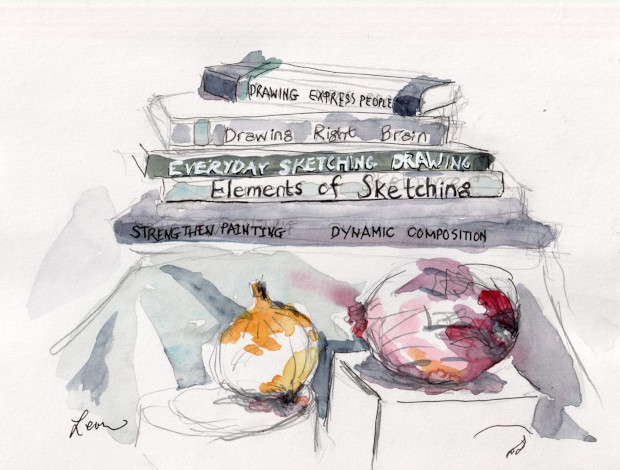
Want instruction from some experts? These are some of my favorite drawing books. You can might be able to take them out of your library. You might then decide you want to own one or more of these books.
Everyday Sketching & Drawing by Steven B. Reddy
The Natural Way to Draw by Kimon Nicolaides
Drawing on the Right Side Brain by Betty Edwards
Draw Your World by Samantha Dion Baker
Keys to Drawing by Bert Dodson
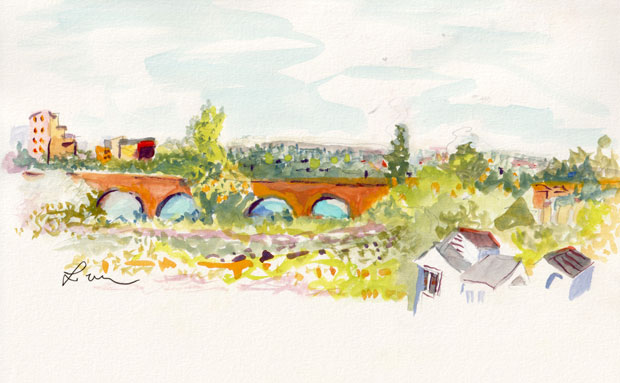
Reds, yellows, and oranges appear in Highland Park in early fall. My paintings get a colorful glow. Pictured is the train bridge that runs from New Brunswick to Highland Park over the Raritan River.
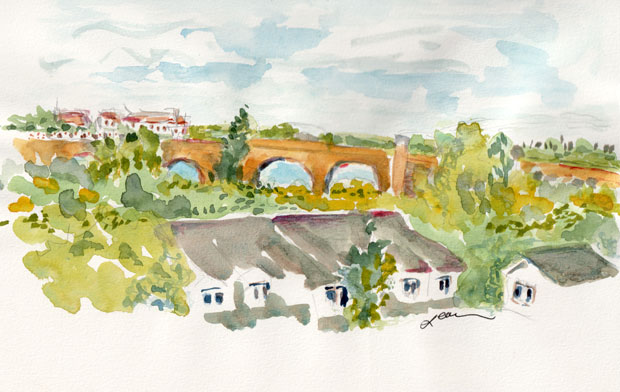
I painted two illustrations of the scene with watercolor and gouache in September.
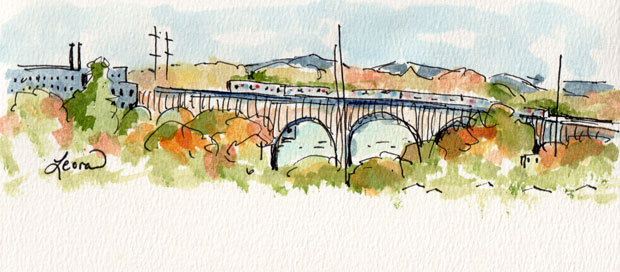
Then I returned to the scene in November with my uniball pen and later colored the ink drawing with watercolor.
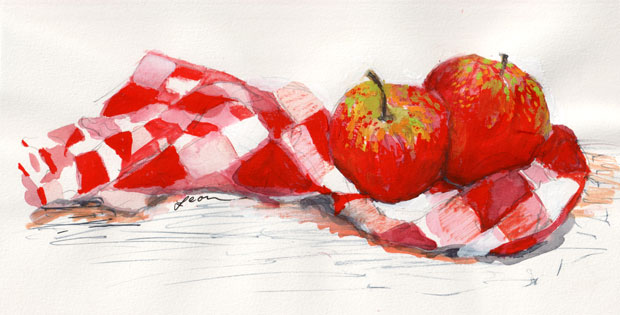
Apples are ripe and delicious in early autumn. My favorites are macintosh, macoun, and winesap. I buy them at the Highland Park Farmers Market.
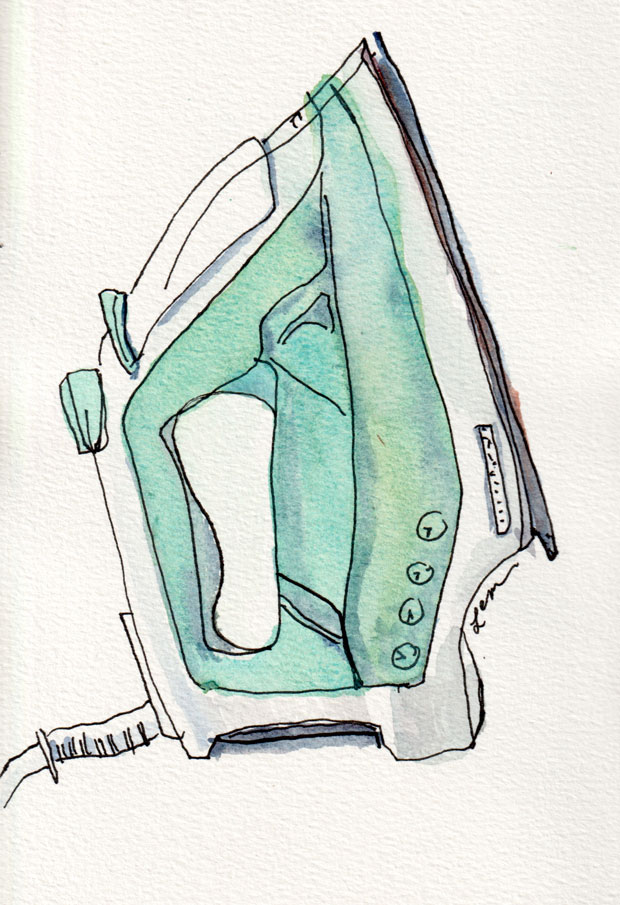
By November it gets too cold for most of us to sit outside and leisurely draw. If you are a beginner at drawing, man-made objects like an iron are easier subjects than drawing outside in nature. With the help of friends, I am working on lessons geared at teaching drawing by really seeing. Right before I drew the iron, I did a “no peeking” exercise: one is not allowed to look at the paper while drawing. It helps a person see the object.
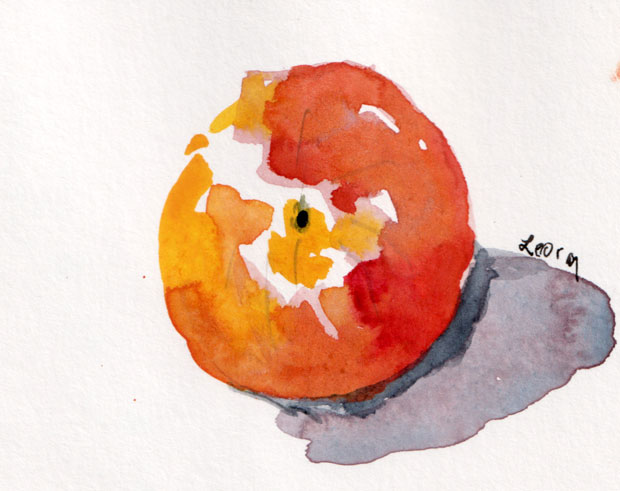
I added this peach painting from the summer as a warm and cozy ending to this autumn blog post.
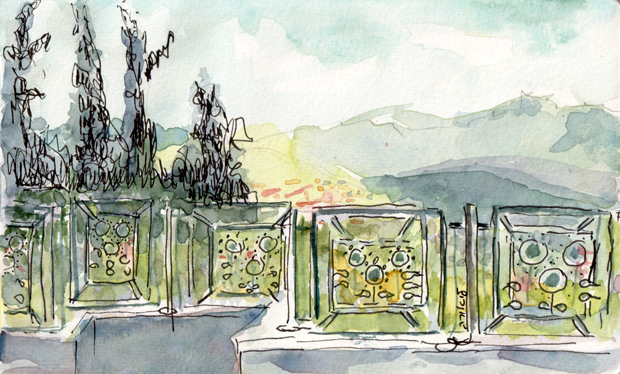
In June 2024 we visited the Galil (Galilee in English), the region in the north western part of Israel, west of the Golan Heights. Some of the places we visited were Beit Keshet, Tsefat, Tiberias, Yodfat, and Maalot. Pictured above is the illustration of the view from my friend’s house in Maalot.
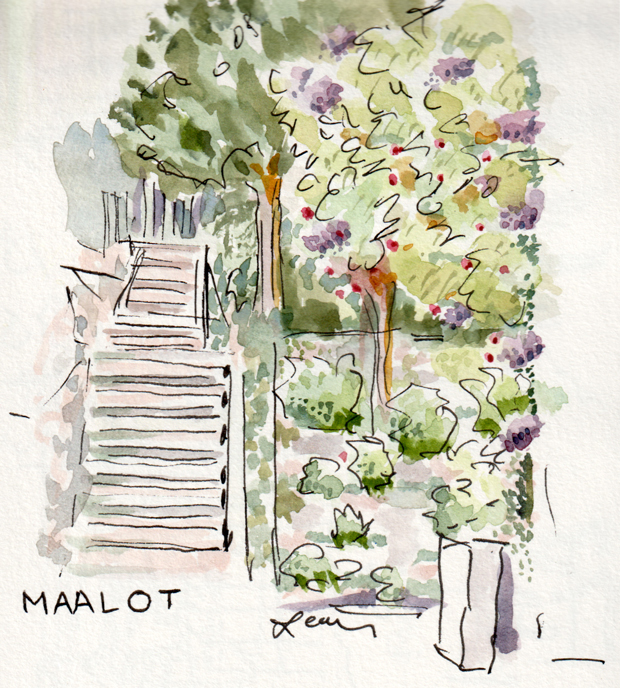
In Maalot my friend and I went on an Maalot sketch crawl. Maalot is hilly. The name Maalot means “steps.” We walked down her block and stopped at some long steps, a common scene in Maalot. The jacaranda tree was in bloom, so I was attracted to that spot. I drew first with my black uniball pen. Next I added some color.
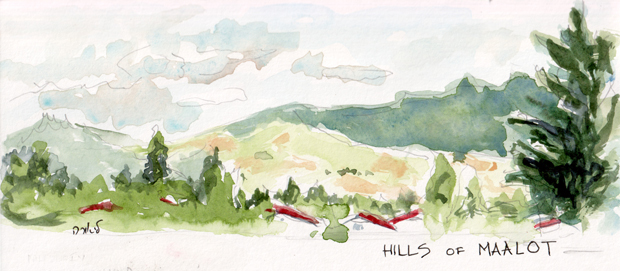
This is another scene of Maalot. The hills around were peaceful and calm.
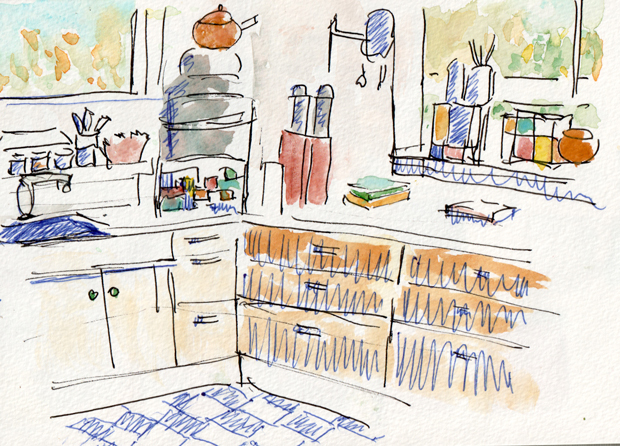
Yodfat is a small community on top of a hill. Historically, it is famous for a Roman siege of Yodfat that took place many years ago. We stayed in a house with many amenities, especially in the kitchen. When I woke up in the morning, I went for a walk all around the village. After a while, it started to get hot, so I came into the air-conditioned kitchen, took out my paints, and began to draw. I drew a corner counter with some windows. I added the ballpoint pen marks later.
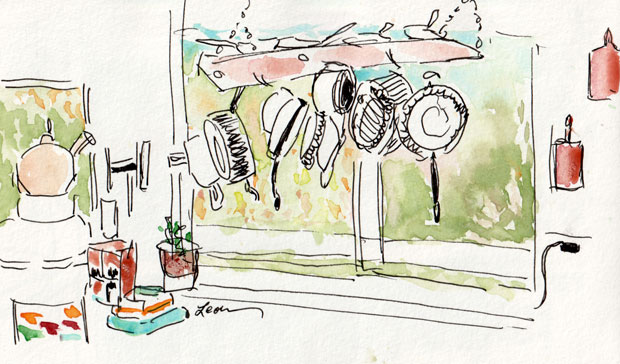
Pots and pans are a lot of fun to draw and paint.
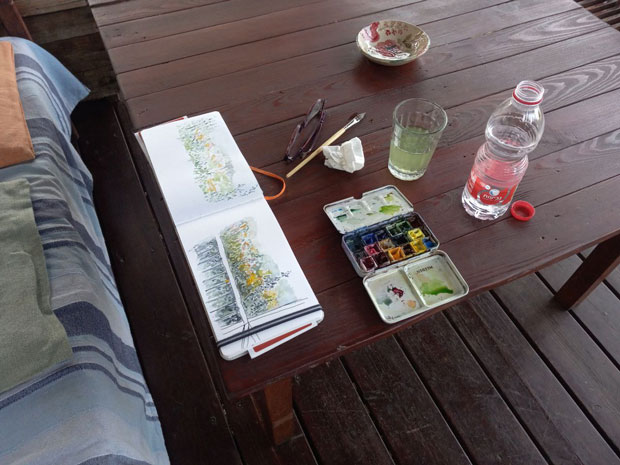
I spent the early morning in Beit Keshet with my paints and the Galil scenery.
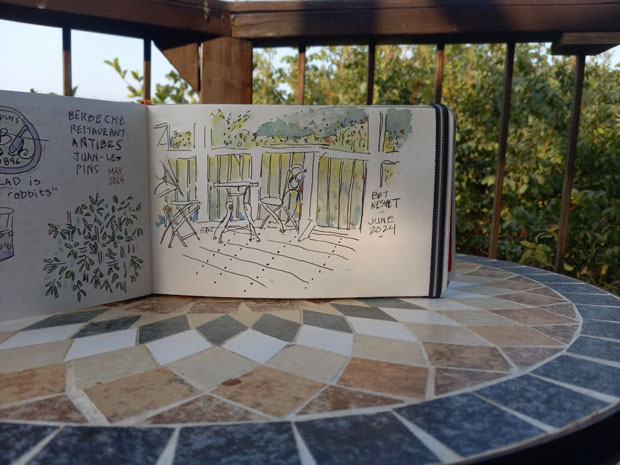
The Beit Keshet cottage had a lovely back porch with an amazing view. I loved the little table in the corner.











































